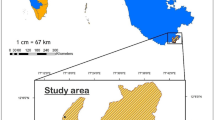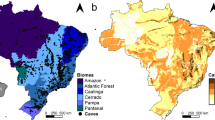Abstract
The Cerrado is considered one of the 25 biodiversity hotspots in the world by conservation organizations. There are few studies on bat taxonomic groups for this biome. Herein we present a bat survey employing mist nets in the protected area of a private natural heritage reserve Reserva Particular do Patrimônio Natural Pousada das Araras, located in the west-central Brazil. We investigate the hypothesis that the Cerrado habitat complexity plays a role on the different structuring forces in bat ecological communities. Bats represent a diversity of trophic levels, and they occupy a wide range of available Cerrado habitats and microhabitats. The patterns and processes we discuss represent the factors influencing coexisting species of bats in different habitats and their implications for conservation. We captured 758 individuals of 25 species belonging to four families. Phyllostomidae was the dominant family, represented by 20 species (80%). The average recapture rate was 6.2%, and the species with most proportional recapture was A. caudifer. Greater species richness was observed among bats with predominantly insectivore habits, followed by frugivores. Glossophaga soricina was a dominant species, with about 30% of the captures. There was seasonal variation relating to the number of bats captured, with greater bat frequency occurring during the wet season, although some species occurred at higher rates during the dry season, such as C. perspicillata and S. lilium. Sanguivore bats were abundant, reflecting the availability of shelters and food supply (livestock) in the surrounding area. Compared to other surveyed areas, Pousada das Araras may be considered of high species diversity, supplanting the majority of known Cerrado studied areas. Apparently Cerrado favours the occurrence of insectivore species, with emphasis on the foliage-gleaning insectivores belong to the subfamily Phyllostominae. This study indicates that apparently the conservation of the Cerrado savanna fragments can support a considerable diversity of bat species.








Similar content being viewed by others
References
Ab’Saber AN (1971) A organização natural das paisagens inter e subtropicais brasileiras. In: Ferri MG (ed) III Simpósio sobre o Cerrado. Editora da Universidade de São Paulo, São Paulo
Aguiar LMS, Marinho-Filho JS (2004). Activity patterns of nine phyllostomid bat species in a fragment of the Atlantic Forest in southeastern Brazil. Rev Bras Zool 21(2):385–390
Alho CJR (2005a). Intergradation of habitats of non-volant small mammals in the patchily Cerrado Landscape. Arquivos do Museu Nacional, Rio de Janeiro 63(1):41–48
Alho CJR (2005b) Desafios para a conservação do Cerrado face às atuais tendências de uso e ocupação. In: Scariot A, Silva JCS, Felfili JM (eds) Cerrado: Ecologia, Biodiversidade e Conservação. Ministério do Meio Ambiente, Brasília-DF
Arita HT (1993) Rarity in neotropical bats: correlations with phylogeny, diet, and body mass. Ecol Appl 3(3):506–517
Bernard E (2001) Vertical stratification of bat communities in primary forests of Central Amazon, Brazil. J Trop Ecol 17:115–126
Bernard E, Fenton MB (2002) Species diversity of bats (Mammalia: Chiroptera) in forest fragments, primary forests and savannas in Central Amazonia, Brazil. Can J Zool 80:1124–1140
Bianconi GV, Mikich SB, Pedro WA (2004) Diversidade de morcegos (Mammalia, Chiroptera) em remanescentes florestais do município de Fênix, noroeste do Paraná, Brasil. Rev Bras Zool 21(4):943–954
Bredt A, Uieda W, Magalhães ED (1999) Morcegos cavernícolas da região do Distrito Federal, centro-oeste do Brasil (Mammalia, Chiroptera). Rev Bras Zool 16(3):731–770
Coimbra CEA Jr, Borges MM, Guerra DQ et al (1982) Contribuição à zoogeografia e ecologia de morcegos em regiões de Cerrado do Brasil Central. Bol Téc Rev Brasil Florestal 7:34–38
Dias D, Peracchi AL, Silva SSP (2002) Quirópteros do Parque Estadual da Pedra Branca, Rio de Janeiro, Brasil (Mammalia, Chiroptera). Rev Bras Zool 19(2):113–140
Eisenberg JF, Redford KH (1999) Mammals of the Neotropics. The Central Neotropics. University of Chicago Press, Chicago
Eiten G (1972) The cerrado vegetation of Brazil. Bot Rev 38:201–241
Emmons LH, Feer F (1997) Neotropical rainforest mammals. A field guide, 2nd edn. University of Chicago Press, Chicago
Esbérard CEL (2003) Diversidade de morcegos em área de Mata Atlântica regenerada no Sudeste do Brasil. Rev Bras Zoociências 5(2):189–211
Falcão FC, Rebelo VF, Talamoni AS (2003) Structure of a bat assemblage (Mammalia, Chiroptera) in Serra do Caraça Reserve, South-east Brazil. Rev Bras Zool 20(2):347–350
Funatura (1999) Plano de manejo Reserva Natural Pousada das Araras. Brasília
Fleming TH (1986) Opportunism versus specialization: the evolution of feeding strategies in frugivorous bats. In: Estrada A, Fleming TH (eds) Frugivores and seed dispersal. W. Junk Publishers, pp 105–118
Gardner AL (1977) Feeding habits. In: Barker RJ, Jones JK Jr, Carter DC (eds) Biology of bats of the New World family Phyllostomatidae, Part II. Spec Publ Mus Texas Tech Univ 13:1–364
Gargaglioni LH, Batalhão ME, Lapenta MJ et al (1998) Mamíferos da Estação Ecológica de Jataí, Luiz Antônio, São Paulo. Pap Av Zool 40(17):267–278
Gonçalves E, Gregorin R (2004) Quirópteros da Estação Ecológica Serra das Araras, Mato Grosso, Brasil, com o primeiro registro de Artibeus gnomus e A. anderseni para o Cerrado. Lundiana 5:143–149
Gregorin R, Ditchfield AD (2005) A new genus and species of Lonchophyllini nectar-feeding bat (Phyllostomidae: Glossophaginae) from Northeastern Brazil. J Mammal 86(2):403–414
Gregorin R, Gonçalves E, Lim BK et al (2006) New species of disk-winged bat Thyroptera and range extension for T. discifera. J Mammal 87(2):238–246
Handley CO Jr (1967) Bats of the canopy of an Amazonian forest. Atas Simp Biota Amaz Zool 5:211–215
Humphrey SR, Bonaccorso FJ, Zinn TL (1983) Guild structure of surface-gleaning bats in Panama. Ecology 64(2):284–294
Kalko EKV (1998) Organisation and diversity of tropical bat communities through space and time. Zoology 101(4):281–297
Leite AP, Meneghelli M, Taddei VA (1998) Morcegos (Chiroptera: Mammalia) dos pantanais de Aquidauana e da Nhecolândia, Mato Grosso do Sul. I. Diversidade de espécies. Ens Ciênc 2(2):167–174
Lim BK, Engstrom MD, Lee TE et al (2004) Molecular differentiation of large species of fruit-eating bats (Artibeus) and phylogenetic relationships based on the cytochrome b gene. Acta Chirop 6(1):1–12
Lima JEFW, Silva EM (2005). Estimativa da produção hídrica superficial do Cerrado brasileiro. In: Scariot A, Sousa-Silva JC, Felfili JM (org.) Cerrado: Ecologia, Biodiversidade e Conservação, Ministério do Meio Ambiente, Brasília-DF
Machado RB, Ramos Neto MB, Pereira PGP et al (2004) Estimativas de perda da área do Cerrado brasileiro. Relatório técnico não publicado. Conservação Internacional, Brasília
Magurran AE (1988) Ecological diversity and its measurement. Croom Helm Limited, London
Marinho-Filho JS (1996) The Brazilian Cerrado Bat Fauna and its conservation. Chirop Neotrop 2(1):37–39
Marinho-Filho JS, Sazima I (1998) Brazilian bats and conservation biology: a first survey. In: Kunz TH, Racey PA (eds) Bat biology and conservation. Smithsonian Institution Press, Washington
Marques SA (1985) Novos registros de morcegos do Parque Nacional da Amazônia (Tapajós) com observações do período de atividade noturna e reprodução. Bol Mus Par Emílio Goeldi, Sér Zool 2(1):71–83
Mello MAR, Schittini GM (2005) Ecological analysis of three bat assemblages from conservation units in the Lowland Atlantic Forest of Rio de Janeiro, Brazil. Chirop Neotrop 11(1):206–210
Miretzki M (2003) Morcegos do Estado do Paraná, Brasil (Mammalia, Chiroptera): riqueza de espécies, distribuição e síntese do conhecimento atual. Pap Avul Zool 43(6):101–138
Mittermeier RA, Myers N, Mittermeier CG (2000) Hotspots: earth’s biologically richest and most endangered terrestrial ecoregions. CEMEX. Moojen J, Locks, Mexico City
Myers N, Mittermeier RA, Mittermeier CG et al (2000) Biodiversity hotspots for conservation priorities. Nature 403:853–858
Pedro WA, Passos FC (1995). Occurrence and food habits of some bat species from the Linhares Forest Reserve, Espírito Santo, Brazil. Bat Res News 36:1–2
Pedro WA, Taddei VA (1997) Taxonomic assemblage of bats from Panga Reserve, southeastern Brazil: abundance patterns and trophic relations in the Phyllostomidae (Chiroptera). Bol Mus Biol Mello Leitão (N Sér) 6:3–21
Pedro WA, Taddei VA (2002) Temporal distribution of five bat species (Chiroptera, Phyllostomidae) from Panga Reserve, south-eastern Brazil. Rev Bras Zool 19:951–954
Peracchi AL, Albuquerque SL (1993) Quirópteros do município de Linhares, Estado do Espírito Santo, Brasil (Mammalia, Chiroptera). Rev Bras Zool 53(4):575–581
Pirlot P (1972) Chiropteres de Moyenne Amazonie. Mammalia 36(1):71–85
Portfors CV, Fenton MB, Aguiar LMS et al (2000) Bats from Fazenda Intervales, Southeastern Brazil - Species account and comparison between different sampling methods. Rev Bras Zool 17(2):533–538
Reis NR (1984) Estrutura de comunidade de morcegos na região de Manaus, Amazonas. Rev Bras Biol 44(3):247–254
Reis NR, Muller MF (1995) Bat diversity of forests and open areas in a subtropical region of south Brazil. Ecol Aust 5:31–36
Reis NR, Peracchi AL (1987) Quirópteros da região de Manaus, Amazonas, Brasil (Mammalia, Chiroptera). Bol Mus Par Emílio Goeldi, Sér Zool 3(2):161–182
Reis NR, Schubart HOR (1979) Notas preliminares sobre os morcegos do Parque Nacional da Amazônia (médio Tapajós). Acta Amaz 9(3):507–515
Reis NR, Peracchi AL, Muller MF et al (1996) Quirópteros do Parque Estadual Morro do Diabo, São Paulo, Brasil (Mammalia, Chiroptera). Rev Bras Biol 56(1):87–92
Reis NR, Peracchi AL, Sekiama ML et al (2000) Diversidade de morcegos (Chiroptera, Mammalia) em fragmentos florestais no Estado do Paraná, Brasil. Rev Bras Zool 17(3):697–704
Rodrigues FHG, Silveira L, Jácomo ATA et al (2002) Composição e caracterização da fauna de mamíferos do Parque Nacional das Emas, Goiás, Brasil. Rev Bras Zool 19(2):589–600
Sampaio EM, Kalko EKV, Bernard E et al (2003) A biodiversity assessment of bats (Chiroptera) in a tropical lowland rainforest of central Amazonia, including methodological and conservation considerations. Stud Neotrop Fauna Environ 38(1):17–31
Scariot A, Sousa-Silva JC, Felfili JM (2005) Cerrado: Ecologia, Biodiversidade e Conservação. Ministério do Meio Ambiente, Brasília-DF
Simmons NB (2005) Chiroptera. In: Wilson DE, Reeder DM (eds) Mammal species of the world, a taxonomic and geographic reference. Johns Hopkins University Press
Sipinski EAB, Reis NR (1995) Dados ecológicos dos quirópteros da Reserva Volta Velha, Itapoá, Santa Catarina, Brasil. Rev Bras Zool 12(3):519–528
Taddei VA (1996) Sistemática de quirópteros. Bol Inst Pasteur 1(2):3–15
Taddei VA, Reis NR (1980) Notas sobre alguns morcegos da Ilha de Maracá, Território Federal de Roraima (Mammalia, Chiroptera). Acta Amaz 10(2):363–368
Taddei VA, Rezende IM, Camora D (1990) Notas sobre uma coleção de morcegos de Cruzeiro do Sul, rio Juruá, Estado do Acre (Mammalia, Chiroptera). Bol Mus Par Emílio Goeldi, Sér Zool 6(1):75–88
Teixeira SC, Peracchi AL (1996) Morcegos do Parque Estadual da Serra da Tiririca, Rio de Janeiro, Brasil (Mammalia, Chiroptera). Rev Bras Zool 13(1):61–66
Trajano E. (1985) Ecologia de populações de morcegos cavernícolas em uma região cárstica do sudeste do Brasil. Rev Bras Zool 2(5):255–320
Willig MR (1983) Composition, microgeographic variation, and sexual dimorphism in Caatinga and Cerrado bat communities from northeast Brazil. Bull Carnegie Mus Nat Hist 23:1–131
Willig MR, Presley SJ, Owen RD et al (2000) Composition and structure of bat assemblages in Paraguay: a subtropical-temperate interface. J Mammal 81(2):386–401
Zortéa M (2003) Reproductive patterns and feeding habits of three nectarivorous bats (Phyllostomidae: Glossophaginae) from the Brazilian Cerrado. Int J Biol 63(1):159–168
Zortéa M, Tomaz LAG (2006) Dois novos registros de morcegos (Mammalia, Chiroptera) para o Cerrado do Brasil central. Chiroptera Neotropical 12(2):280–285
Acknowledgements
This work was supported by WWF-Brasil (Worldwide Fund for Nature). CAPES (Coordenação de Aperfeiçoamento de Pessoal de Nível Superior) granted M. Zortéa a fellowship. We are especially indebted to the staff of Pousada das Araras for their permission to carry out our study in the reserve, and to. M. H. Assis, E. Nascimento, Q. M. Zortéa and J. G. Duarte for their valuable help during the fieldwork.
Author information
Authors and Affiliations
Corresponding author
Rights and permissions
About this article
Cite this article
Zortéa, M., Alho, C.J.R. Bat diversity of a Cerrado habitat in central Brazil. Biodivers Conserv 17, 791–805 (2008). https://doi.org/10.1007/s10531-008-9318-3
Received:
Accepted:
Published:
Issue Date:
DOI: https://doi.org/10.1007/s10531-008-9318-3




